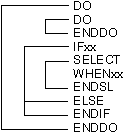
The structured programming operations are shown in the following table.
| Operation | Traditional Syntax | Free-Form Syntax |
|---|---|---|
| And | ANDxx (And) | AND operator |
| Do | DO (Do) | FOR (For) |
| Do Until | DOU (Do Until) or DOUxx (Do Until) | DOU (Do Until) |
| Do While | DOW (Do While) or DOWxx (Do While) | DOW (Do While) |
| Else | ELSE (Else) | |
| Else If | ELSEIF (Else If) | |
| End | ENDyy (End a Structured Group) | |
| For | FOR (For) | |
| If | IF (If) or IFxx (If) | IF (If) |
| Iterate | ITER (Iterate) | |
| Leave | LEAVE (Leave a Do/For Group) | |
| Or | ORxx (Or) | OR operator |
| Otherwise | OTHER (Otherwise Select) | |
| Select | SELECT (Begin a Select Group) | |
| When | WHEN (When True Then Select) or WHENxx (When True Then Select) | WHEN (When True Then Select) |
The DO operation allows the processing of a group of calculations zero or more times starting with the value in factor 1, incrementing each time by a value on the associated ENDDO operation until the limit specified in factor 2 is reached.
The DOU and DOUxx (Do Until) operations allow the processing of a group of calculations one or more times. The end of a Do-Until operation is indicated by an ENDDO operation.
The DOW and DOWxx (Do While) operations allow the processing of a group of calculations zero or more times. The end of a Do-While operation is indicated by an ENDDO operation.
The FOR operation allows the repetitive processing of a group of calculations. A starting value is assigned to the index name. Increment and limit values can be specified, as well. Starting, increment, and limit values can be free-form expressions. An ENDFOR operation indicates the end of the FOR group.
The LEAVE operation interrupts control flow prematurely and transfers control to the statement following the ENDDO or ENDFOR operation of an iterative structured group. The ITER operation causes the next loop iteration to occur immediately.
The IF and IFxx operations allow the processing of a group of calculations if a specified condition is satisfied. The ELSE operation allows you to specify a group of calculations to be processed if the condition is not satisfied. The ELSEIF operation is a combination of an ELSE operation and an IF operation. The end of an IF or IFxx group is indicated by ENDIF.
The SELECT, WHEN, WHENxx, and OTHER group of operations are used to conditionally process one of several alternative sequences of operations. The beginning of the select group is indicated by the SELECT operation. The WHEN and WHENxx operations are used to choose the operation sequence to process. The OTHER operation is used to indicate an operation sequence that is processed when none of the WHENxx conditions are fulfilled. The end of the select group is indicated by the ENDSL operation.
The ANDxx and ORxx operations are used with the DOUxx, DOWxx, WHENxx, and IFxx operations to specify a more complex condition. The ANDxx operation has higher precedence than the ORxx operation. Note, however, that the IF, DOU, DOW, and WHEN operations allow a more straightforward coding of complex expressions than their xx counterparts.
*...1....+....2....+....3....+....4....+....5....+....6....+....7...
CL0N01Factor1+++++++Opcode(E)+Factor2+++++++Result++++++++Len++D+HiLoEq....
*
* In the following example, indicator 25 will be set on only if the
* first two conditions are true or the third condition is true.
*
* As an expression, this would be written:
* EVAL *IN25 = ((FIELDA > FIELDB) AND (FIELDA >= FIELDC)) OR (FIELDA < FIELDD)
*
*
C FIELDA IFGT FIELDB
C FIELDA ANDGE FIELDC
C FIELDA ORLT FIELDD
C SETON 25
C ELSE
C SETOFF 25
C ENDIFA DO, DOUxx, DOWxx, FOR, IFxx, MONITOR, or SELECT operation (with or without ANDxx or ORxx operations), and an ENDyy operation, delimit a structured group. The ENDDO operation ends each DO, DOUxx, and DOWxx group or causes the structured group to be reprocessed until the specified ending conditions are met. The ENDFOR operation ends each FOR group. The SELECT must end with an ENDSL. An IFxx operation and an IFxx operation with an ELSE operation must end with an ENDIF operation.
The rules for making the comparison on the ANDxx, DOUxx, DOWxx, IFxx, ORxx and WHENxx operation codes are the same as those given under Compare Operations.
In the ANDxx, DOUxx, DOWxx, IFxx, ORxx, and WHENxx operations, xx can be:
In the ENDyy operation, yy can be:
If a structured group, in this case a do group, contains another complete structured group, together they form a nested structured group. Structured groups can be nested to a maximum depth of 100 levels. The following is an example of nested structured groups, three levels deep:

Remember the following when specifying structured groups: